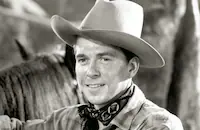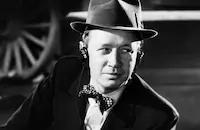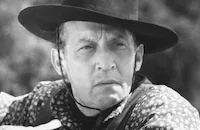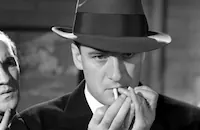Love Is on the Air

Brief Synopsis
Cast & Crew
Nick Grinde
Ronald Reagan
June Travis
Eddie Acuff
Ben Weldon
Robert Barrat
Film Details
Technical Specs

Synopsis
After he announces he will prove that club owner Nicey Ferguson is linked with organized crime, the president of the Better Business Bureau, Mr. Copelin, disappears, along with the company payroll. Radio announcer Andy McCaine broadcasts the news, stating that there is nothing to link Copelin with the missing money, and is warned by his sponsor, department store owner E. E. Nichols, to leave politics out of his program. When Andy refuses, he is fired. Andy points out that his contract doesn't allow him to be fired, so his boss puts him to work broadcasting the children's hour. Meanwhile, Dunk Glover, Andy's legman, continues to investigate Copelin's disappearance. Andy decides to take the program on location, broadcasting the activities of children. One boy, Mouse Malone, writes to Andy and invites him to see a boxing match that he is presenting. Mouse reveals to Andy that he believes Nicey Ferguson killed his brother Danny. He tells Andy that the night Copelin disappeared, Danny was asked to do a cement job and later was killed. The address Danny was sent to was the same address Copelin went to before he vanished. Andy investigates and learns that the house belongs to Weston, the chief accountant at Copelin's business. In the garage, under an oil slick, Andy finds new cement and assumes that it is Copelin's grave. He suspects that Danny was killed to keep him quiet. Pretending to be interested in buying the house, Andy calls Weston. He trails Weston to Nicey's club and follows both of them back to the house, where they dig up Copelin's body. The police identify the body, and Andy starts to broadcast from the murder site. A shoot-out between Nicey and the police ensues and Nicey is killed. Nichols is discovered in the house with Nicey and is arrested by the police. Vindicated, Andy gets his old job back.

Director
Nick Grinde
Cast

Ronald Reagan

June Travis

Eddie Acuff
Ben Weldon

Robert Barrat

Addison Richards

Raymond Hatton
Tommy Bupp

Dickie Jones

Willard Parker
William Hopper
Spec O'donnell
Herbert Rawlinson
Mary Hart

Jack Mower
Harry Hayden
Don Deering
Sunny Bupp
Marianne Edwards
Priscilla Lyon
Johnnie Pirrone Jr.
Henry Hanna
George Billings
Jerry Tucker
Margaret Davis
John Harron
Jack Richardson
Glen Cavender
Johnnie Morris

Elliott Sullivan
Alan Davis
Cliff Saum
Lee Shumway
Edwin Stanley
John H. Elliott
John Dilson
Billy Wayne
Ann Howard
Fern Barry
Julia Perkins
Ray Nichols
Crew
George Bricker
Roy Chanslor
Pat C. Flick
Bryan Foy
Doug Gould
Morton Grant
Marshall Hageman
Leslie Hewitt
Max Parker
Carrol Sax
Howard Shoup
James Van Trees
Jack L. Warner

Film Details
Technical Specs

Articles
Love Is on the Air
By Violet LeVoit

Love Is on the Air
Love is On the Air - Love is on the Air
Ronald Reagan got his start acting in college but when he signed with Warner Bros. in 1937, all of his professional experience was in radio. He began as a sportscaster in Iowa announcing the Chicago Cubs games. While on the road with the Cubs in California, he landed a screen test at Warners and was subsequently signed to a seven-year contract. It was unusual for an unknown to be plucked off the radio and signed to a contract at one of Hollywood's biggest studios but Reagan had even better luck - he scored the lead in his first picture. It was an entrée into the entertainment industry almost as storied as his later political career.
Reagan did receive a slight makeover in his transition from radio to the silver screen. He worked with a dialogue coach, was given a haircut and some sleeker clothes. He was also treated to a shirt fitting by James Cagney's personal shirt maker. Evidently the cameraman on Love Is on the Air complained that Reagan's neck appeared too short on film (it was a problem for Cagney as well). The shirt maker was called in to create a deep V collar style for him. Reagan reportedly wore this same style of shirt for the rest of his life.
For his work in Love Is on the Air, Reagan received $200 a week. The film took just three weeks to shoot and it received generally positive reviews. The Hollywood Reporter was especially generous in its praise, saying, "Love Is on the Air presents a new leading man, Ronald Reagan, who is a natural, giving one of the best first picture performances Hollywood has offered in many a day." Clearly the studio intended take full advantage of Reagan's winning appeal and by the end of 1939, he had already appeared in eighteen films. Among them were Brother Rat (1938), Secret Service of the Air (1939) and Dark Victory (1939). Reagan, who struck up a friendship with producer Bryan Foy from the start, later joked that Foy created B-movies just to keep him on salary.
Joining Reagan in Love Is on the Air was June Travis, who also had a Chicago sports connection; her father was vice president of the White Sox. Reputedly, Travis was discovered at a White Sox game by a Paramount executive. She made her film debut at Warners in Stranded (1935) which starred Kay Francis and George Brent. Over the next four years, Travis appeared in twenty-nine films all of them B-movies. Some of her more popular titles include: the Cagney-Pat O'Brien aviation drama Ceiling Zero; the Joe E. Brown comedy Earthworm Tractors; and the Perry Mason mystery The Case of the Black Cat (all released in 1936). Travis retired from movies in 1939 to get married. She would return to the big screen just twice: first, to play a fairly prominent role in the Bette Davis Hollywood drama The Star (1952) and then, to make her last film appearance in the grade-Z sci-fi travesty, Monster a Go-Go (1965).
Love Is on the Air represents the mid-point of Travis' 31-film career and she very likely helped ease Reagan's transition from the world of sports into moviemaking. Certainly Reagan's first Hollywood film experience seems to have been a positive one. He later remarked, "right from the start, down amongst the 'B' pictures...I was sure that I was in the right business for me."
Producer: Bryan Foy, Hal B. Wallis, Jack L. Warner
Director: Nick Grinde
Screenplay: Roy Chanslor, Morton Grant, George Bricker, Pat C. Flick
Cinematography: James Van Trees
Film Editing: Doug Gould
Art Direction: Max Parker
Cast: Ronald Reagan (Andy McCaine), June Travis (Jo Hopkins), Eddie Acuff (Dunk Glover), Ben Welden (Nicey Ferguson), Robert Barrat (J.D. Harrington), Addison Richards (E.E. Nichols).
BW-59m.
by Stephanie Thames
Love is On the Air - Love is on the Air
Ronald Reagan, 1911-2004 - TCM Remembers Ronald Reagan
Ronald Reagan, the actor turned elected official whose fascinating career saw him develop as a contract player for Warner Brothers studios, to a politician who fulfilled his ambitions by becoming the 40th President of the United States, died at his home in Los Angeles on June 5 after a long battle with Alzheimer's disease. He was 93.
He was born Ronald Wilson Reagan on February 6, 1911 in Tampico, Illinois to John and Nelle Reagan. When Reagan was nine, his family settled down in the small community of Dixon, about 100 miles west of Chicago. After high school, Reagan enrolled in Eureka College, a small Christian school near Peoria. He graduated in 1932 with a degree in Economics, and pursued a career in broadcasting. His first gig was as a part-time announcer at WOC in Davenport, Iowa. Within a year, WOC had merged with its big-sister station, WHO in Des Moines, and Reagan was hired as a sports announcer.
In the spring of 1937, Reagan drove to Southern California to catch the Chicago Cubs in spring training on Santa Catalina Island. While he was in California, he wrangled a screen test and signed a contract for $200 a week with Warner Brothers. His film debut was rather inauspicious; he portrayed a radio announcer in an innocuous comedy Love is on the Air (1937). He made a few more "B" programmers like Hollywood Hotel (also 1937), and Girls on Probation (1938), before getting his first prominent role opposite Bette Davis in the popular tearjerker, Dark Victory (1939).
Although he seldom got credit for being a good actor, there was no denying that Reagan held his own given the right material: Knute Rockne, All American as the doomed Notre Dame football hero George "The Gipper" Gipp, where he delivered the film's immortal line "Win one for the Gipper!"; Santa Fe Trail in which he ably supports Errol Flynn in one of the boxoffice hits of its era (both 1940); Kings Row (1941), featuring one of his finest performances as a small-town playboy whose legs are amputated by a careless surgeon; and Desperate Journey (1942) where he again supported Flynn in an exciting action picture.
Due to his poor eyesight, Reagan didn't see any action in World War II, so the studio heads assigned him to star in a series of patriotic films produced by the First Motion Picture Unit of the Army Air Forces in Culver City. Between 1942-45, Reagan starred in over 400 of these films. After the war, Reagan still found some good roles: The Voice of the Turtle (1947) proved he had a deft hand at light comedy opposite Eleanor Parker; The Hasty Heart (1949) offered another underrated performance as he ably portrayed the Yank in John Patrick's much heralded wartime play; and Storm Warning (1950) was a slick melodrama that cast Reagan as a crusading District Attorney determined to bring the KKK in a small southern town, with the help of Doris Day and Ginger Rogers!
It was around this time that Reagan became involved in politics. In 1947, he began a five-year term as president of the Screen Actors Guild (SAG), and testified in October of that year before the newly formed House Un-American Activities Committee (HUAC). He identified suspected Communists Larry Parks, Howard Da Silva and Alexander Knox, all of whom were subsequently called to testify, and subsequently blacklisted. Later records showed Reagan was so concerned about the Communist influence in Hollywood, that he became an FBI informer.
As Reagan became steeped in his political career, his parts throughout the '50s became inferior: the notorious Bedtime for Bonzo (1951); the coy "sex" comedy She's Working Her Way Through College (1952) that cast him as a college professor who romances a stripper! (Virginia Mayo); Cattle Queen of Montana (1955), a sluggish Western that even the redoubtable Barbara Stanwyck couldn't save; and finally Hellcats of the Navy (1957), a stodgy war picture that would be his only film that co-starred his wife Nancy (Davis).
Television offered some salvation. For eight years, (1954-62), Reagan served as the host of General Electric Theater, a televised series of dramas. He also found a niche as GE's goodwill ambassador to employees and to civic and business groups around the country, furthering his taste and honing his craft as a public official. By the mid '60s, Reagan would move into politics entirely, save for one last film, the thrilling The Killers (1964), Reagan's only known villainous role, as a murderous gangster. That same year, he actively campaigned for Republican Presidential candidate Barry Goldwater, although Goldwater lost to Lyndon B. Johnson.
Reagan whose profile was riding high, had cemented his future as a successful politician. In 1966, he ran against incumbent Governor Pat Brown for the state of California and won, serving successfully for two terms until 1974.
Reagan began an all-out, two-year drive to wrest the 1976 nomination from incumbent Gerald R. Ford, an appointed vice president who became president on the resignation of Nixon. Reagan fell short by a handful of delegates to the Republican national convention. But Ford lost to Jimmy Carter, and Reagan became the front-runner to challenge Carter in 1980. After defeating Carter, Reagan held two terms as President of the United States (1981-89). After his second term was over, he retired quietly in California. In 1994, it was revealed to the media that Reagan was suffering from Alzheimer's disease; he had been kept out of the public eye since then.
He was married briefly to actress Jane Wyman (1940-48), and had two children; a daughter Maureen and an adopted son, Michael. In 1952, he married a budding film starlet, Nancy Davis, who bore him two more children; a daughter, Patty; and a son, Ronald Jr. Ronald Reagan is survived by Nancy, Michael, Patty and Ron Jr. His daughter Maureen died of Melanoma in 2001 at the age of 60.
by Michael T. Toole
Ronald Reagan, 1911-2004 - TCM Remembers Ronald Reagan
Quotes
Trivia
Notes
The film's working title was Inside Story. Love Is on the Air marked the motion picture debut of Ronald Reagan (1911-2004), future president of the United States (1981-1989). For information on remakes of this film see entry above for Hi! Nellie.

Miscellaneous Notes
Released in United States Fall October 2, 1937
Remake of "Hi Nellie" (USA/1934) directed by Mervyn LeRoy.
Feature acting debut for Ronald Reagan.
Remade as "Love Is on the Air" (1937), "You Can't Escape Forever" and "The House Across the Street" (1949).
Released in United States Fall October 2, 1937














